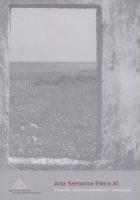Vabadus ja ideaalid: kirjanduse sotsiaalne modelleeriv funktsioon Johannes Semperi romaanis „Kivi kivi peale”
Freedom and ideals: the social modelling function of literature in Johannes Semper’s novel “Kivi kivi peale”
Author(s): Tanel PernSubject(s): Sociology, Social Theory, Theory of Literature
Published by: Eesti Semiootika Selts
Keywords: Ideology; social modelling; model; Johannes Semper;
Summary/Abstract: This paper focuses on the different aspects of modelling the society in Johannes Semper’s novel, “Kivi kivi peale” (“Stone upon stone”). The literary text is discussed here from the aspect of its social modelling function. Social modelling can be seen from two different perspectives: on one hand, the literary text borrows models from the society, idealizes situations and reworks them for its individual purposes. On the other hand, literature functions as a source of models for the society – both its individual members and the society as a whole. Just as the reception of the literary text can change in different situations, so does its status as a model. Semper’s novel presents the social reality of 1930s Estonia through the point of view of an architect. As a consequence, houses or homes are the most important type of models in the novel. On one hand, these permit presenting a certain “cross-section” of the society. On the other hand, they express a certain idea of creative freedom and by enabling the reader to “live through” this concept of freedom through the main characters, they express an understanding of the individual’s freedom of choice and their relationship to the society in general.
Journal: Acta Semiotica Estica
- Issue Year: 2014
- Issue No: 11
- Page Range: 127-144
- Page Count: 18
- Language: Estonian

